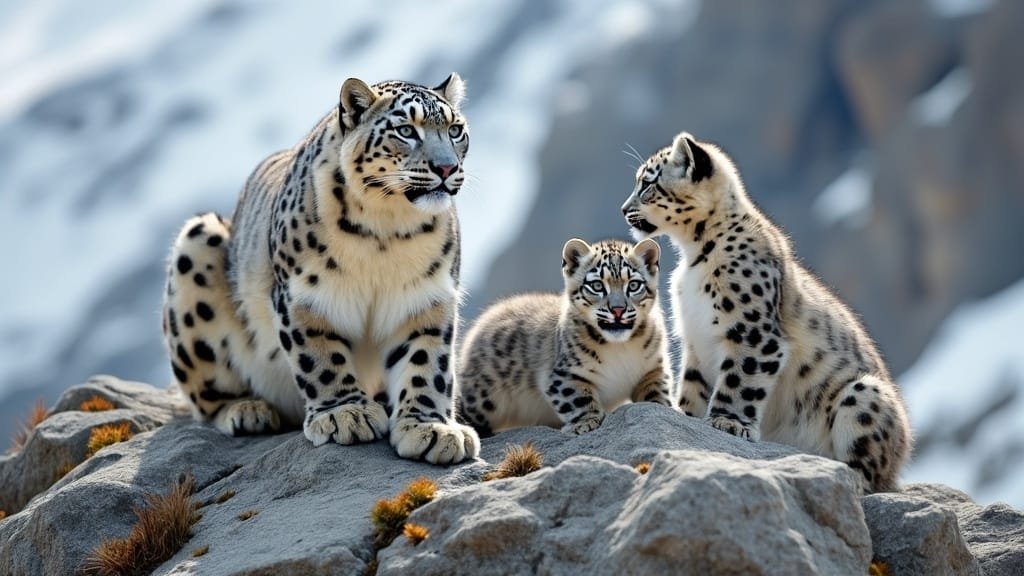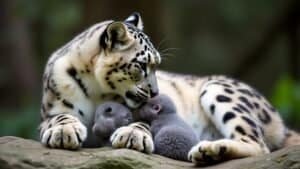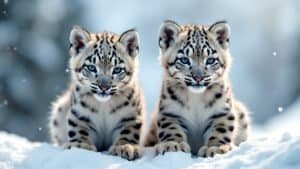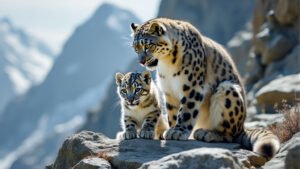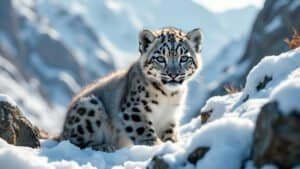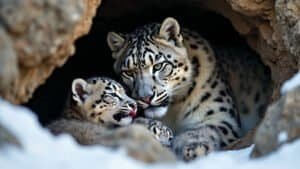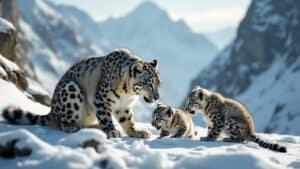Introduction
The reproductive success of snow leopards is influenced by a delicate interplay of genetic, environmental, and behavioral factors
These elusive big cats face numerous challenges, including habitat fragmentation, prey scarcity, and the impacts of climate change, all of which affect their ability to mate, rear cubs, and maintain healthy populations
Maternal care plays a critical role in cub survival, with mothers providing essential guidance and protection during their early years. Furthermore, human activities such as poaching and habitat destruction pose significant threats to their reproductive outcomes
This article explores the key factors shaping the reproductive success of snow leopards, the importance of prey availability and habitat quality, and the conservation efforts required to ensure their survival
What Factors Influence the Reproductive Success of Snow Leopards?
Snow leopards inhabit the high-altitude regions of Central and South Asia. Their reproductive success depends on a combination of genetic health, environmental stability, and behavioral strategies
Each of these factors plays a critical role in maintaining viable populations of this endangered species
Genetic Diversity and Its Role in Fertility
Genetic diversity is fundamental to the reproductive success of snow leopards. High levels of genetic variation reduce the risk of inbreeding and associated health issues such as decreased fertility, reduced cub viability, and increased susceptibility to disease
In small, isolated populations, inbreeding depression is a significant concern, as it can lead to the accumulation of deleterious alleles, weakening the gene pool
Studies have shown that snow leopard populations with restricted genetic diversity, often due to habitat fragmentation, experience lower reproductive rates. Conservation initiatives that promote genetic connectivity between fragmented populations—such as wildlife corridors—are critical for enhancing genetic health and ensuring robust fertility
Programs involving genetic studies and captive breeding also play a vital role in maintaining genetic diversity within the species
Environmental Influences on Reproduction
The harsh environments snow leopards inhabit significantly influence their reproductive success. Factors such as prey availability, habitat quality, and climatic conditions directly affect their ability to reproduce and rear cubs:
Prey Availability: Snow leopards rely on prey species like blue sheep (Pseudois nayaur) and ibex (Capra sibirica) for nutrition. A consistent prey base ensures that females have the energy reserves necessary for successful pregnancies and lactation. In contrast, prey scarcity, often caused by human activities like overgrazing or hunting, can lead to malnutrition and reproductive failure
Habitat Quality: High-altitude regions provide essential denning sites that offer protection for cubs. Habitat degradation due to infrastructure development or mining reduces the availability of such safe spaces, exposing cubs to predators and environmental hazards
Climate Conditions: Snow leopards typically breed during winter, with cubs born in spring. Extreme weather events caused by climate change, such as unseasonal snowfall or droughts, can disrupt these cycles, affecting cub survival and reproductive timing
Behavioral Traits Affecting Mating Success
Behavioral adaptations are crucial for successful reproduction in snow leopards. These solitary cats rely on a range of vocalizations, scent markings, and behavioral cues to communicate their readiness to mate
Females come into estrus once every two years, and the window for successful mating is short. Any disruption in this behavioral synchronization, whether due to environmental stressors or human interference, can lead to missed breeding opportunities
Maternal care is another vital behavioral aspect influencing reproductive outcomes. Female snow leopards rear their cubs alone, teaching them essential survival skills over 18-22 months
The success of this maternal investment depends on the mother’s health and the availability of resources. Human-induced habitat disturbances, such as encroachment or tourism, can disrupt these critical maternal behaviors, affecting cub survival rates
How Does Prey Availability Impact Snow Leopard Fertility?
Prey availability is one of the most critical factors influencing the reproductive success of snow leopards. These carnivorous predators depend on a consistent supply of prey to maintain their physical health, sustain pregnancies, and successfully rear cubs
Fluctuations in prey populations can have cascading effects on their reproductive outcomes, directly impacting population stability
Prey Abundance and Female Health
A healthy diet rich in high-energy prey is essential for female snow leopards to reproduce successfully
Prey species such as blue sheep (Pseudois nayaur), ibex (Capra sibirica), and Himalayan tahr (Hemitragus jemlahicus) form the bulk of their diet. Adequate prey ensures females can build the energy reserves needed for gestation and lactation
Studies have shown that females in prey-rich habitats exhibit higher pregnancy rates and larger litter sizes. Conversely, in areas with depleted prey populations, females may experience malnutrition, which can lead to lower fertility, prolonged interbirth intervals, and even miscarriage
This is particularly critical during the winter months when prey becomes scarce due to harsh conditions
Seasonal Variations in Prey Resources
Prey populations naturally fluctuate with seasonal changes, and these variations influence snow leopards’ reproductive timing
The breeding season for snow leopards coincides with winter, ensuring that cubs are born in spring when prey availability begins to increase. This synchronization allows mothers to hunt effectively and provide sufficient nourishment for their offspring
However, climate change and habitat disruption have altered these seasonal dynamics. For instance, unseasonal snowfall can drive prey animals to lower altitudes, leaving snow leopards with fewer hunting opportunities in their usual ranges
Such disruptions force snow leopards to expend more energy searching for food, often at the expense of reproduction and cub care
Impact of Prey Scarcity on Cub Survival
The survival of snow leopard cubs is directly tied to the mother’s ability to hunt successfully. In regions where prey is scarce, cub mortality rates are significantly higher
Malnourished mothers may struggle to produce enough milk to sustain their cubs, leading to weakened offspring that are less likely to survive harsh mountain conditions
Human activities, such as overgrazing by livestock and hunting of prey species, exacerbate prey scarcity. Conservation measures that aim to restore prey populations—such as creating protected areas, regulating hunting, and reducing livestock competition—are essential for improving the reproductive success of snow leopards
The Role of Habitat and Climate in Snow Leopard Reproduction
Habitat quality and climate conditions are pivotal factors influencing the reproductive success of snow leopards
As apex predators in high-altitude ecosystems, these animals depend on vast, undisturbed territories and stable environmental conditions to breed and rear their young
However, human activity and climate change are disrupting these delicate ecosystems, threatening the species’ reproductive viability
Effects of Habitat Fragmentation on Breeding
Habitat fragmentation, often caused by infrastructure development, mining, and agriculture, poses a significant threat to snow leopard reproduction
Fragmented habitats limit access to mating opportunities by isolating populations. This isolation not only reduces genetic diversity but also leads to increased competition for limited resources within smaller ranges
Snow leopards require expansive territories, with males often occupying ranges that overlap with multiple females to maximize breeding opportunities. When these territories are disrupted, the likelihood of successful mating decreases
Additionally, fragmented habitats often lack sufficient denning sites, leaving females and cubs vulnerable to predation and harsh environmental conditions
Climate Change and Reproductive Cycles
The impacts of climate change on snow leopard habitats are profound. Rising temperatures are causing glaciers to retreat and altering the distribution of vegetation and prey species
These changes affect the availability of suitable hunting grounds and denning sites, directly impacting reproductive success
For instance, reduced snow cover can make snow leopards more visible to both prey and potential threats, disrupting their hunting efficiency
Climate change also leads to erratic weather patterns, such as unseasonal snowfall or prolonged droughts, which can disrupt the breeding season and reduce the survival rates of cubs born during unfavorable conditions
Denning Site Availability and Cub Rearing
Denning sites play a critical role in the reproduction and survival of snow leopard cubs
These dens provide shelter from predators and harsh weather, creating a safe environment for mothers to care for their young. Ideal denning sites are typically located in rugged, remote terrain with limited human disturbance
Habitat degradation often reduces the availability of these vital shelters. When females are forced to select suboptimal den sites, cub survival rates decline. Conservation efforts focused on protecting and restoring critical habitats can help ensure the availability of safe and secure denning locations for snow leopards
In addressing these challenges, conservation strategies must prioritize habitat preservation and climate resilience to safeguard the reproductive success of snow leopards in the face of growing environmental threats
Maternal Care and Its Importance in Snow Leopard Reproduction
Maternal care is a cornerstone of reproductive success in snow leopards, as it directly influences cub survival and development
Female snow leopards invest significant time and energy in raising their offspring, ensuring they are equipped with the skills necessary to thrive in their harsh environments. This phase of care is critical, as cubs are entirely dependent on their mothers during the first few months of life
Duration and Key Phases of Maternal Care
The period of maternal care in snow leopards lasts approximately 18 to 22 months. This extended dependency allows cubs to grow strong and learn essential survival skills
Maternal care can be divided into three key phases:
Nursing and Protection (Birth to 3 Months): Cubs are born blind and helpless, weighing only about one pound. During this time, the mother remains close to the den, nursing the cubs and guarding them against predators
Weaning and Early Exploration (4 to 12 Months): As the cubs grow, the mother begins introducing them to solid food, often bringing back prey for them to consume. Cubs start exploring the den area under the watchful eye of their mother
Skill Development and Independence (12 to 22 Months): In this phase, cubs accompany their mother on hunting expeditions, learning to stalk, chase, and capture prey. By the end of this period, they are typically ready to establish their own territories
Skills Transferred From Mothers to Cubs
The survival of snow leopard cubs hinges on the skills and knowledge imparted by their mothers. These include:
Hunting Techniques: Cubs learn how to identify, stalk, and capture prey, which is crucial for their survival in the wild
Navigating Terrain: The rugged, high-altitude habitats of snow leopards require cubs to develop exceptional climbing and agility skills
Avoiding Threats: Mothers teach cubs how to avoid predators and minimize risks from human activity
These skills are essential for cubs to survive independently once they leave their mother’s care.
Challenges Faced by Maternal Snow Leopards
Female snow leopards face numerous challenges while raising cubs, many of which stem from environmental and human-induced pressures:
Food Scarcity: Insufficient prey forces mothers to travel greater distances to hunt, leaving cubs unattended for longer periods
Habitat Disturbance: Human activities such as livestock grazing, tourism, and mining can disrupt maternal behavior and reduce the availability of safe denning sites
Climate Impact: Erratic weather conditions, such as unseasonal snowstorms, can make it more difficult for mothers to provide consistent care and protection
Conservation initiatives aimed at protecting habitats, increasing prey populations, and minimizing human-wildlife conflict are vital for supporting maternal snow leopards and enhancing cub survival rates
Human Impact and Conservation Efforts
Human activities have a profound influence on the reproductive success of snow leopards. From habitat degradation to poaching, these impacts threaten the survival of this endangered species
However, concerted conservation efforts are helping to mitigate these challenges and improve reproductive outcomes
How Poaching Affects Snow Leopard Reproduction
Poaching poses one of the most direct threats to snow leopard populations. These animals are hunted for their pelts, bones, and other body parts, which are highly valued in illegal wildlife trade
The removal of adult snow leopards from the population disrupts breeding dynamics, reducing the chances of successful reproduction
Additionally, the loss of key individuals—particularly breeding males or females—can lead to population declines and genetic bottlenecks. This not only reduces reproductive success but also increases the risk of inbreeding and its associated health problems
Role of Community Engagement in Conservation
Community involvement is critical to addressing the threats posed by human activities. Many snow leopard habitats overlap with areas used by local communities for livestock grazing, which often leads to conflicts. Snow leopards preying on livestock can prompt retaliatory killings, further endangering their populations
To mitigate these conflicts, organizations such as the Snow Leopard Trust have implemented community-based programs
These include:
Livestock Insurance Schemes: Compensating herders for losses due to snow leopard predation, reducing the incentive for retaliation
Sustainable Livelihood Projects: Providing alternative income sources to local communities, such as handicrafts or ecotourism, to reduce reliance on livestock
Education and Awareness: Promoting the importance of snow leopard conservation and fostering coexistence
These initiatives not only protect snow leopards but also improve the quality of life for local communities, creating a mutually beneficial relationship
Scientific Research Supporting Reproductive Health
Scientific research plays a crucial role in snow leopard conservation. Studies on genetics, behavior, and ecology provide valuable insights into factors affecting reproductive success
For instance:
Genetic Studies: Help identify populations at risk of inbreeding and guide conservation breeding programs
Behavioral Research: Enhances understanding of mating systems, cub-rearing practices, and habitat use
Prey Population Monitoring: Assists in maintaining healthy prey bases, ensuring sufficient food for breeding females
Advances in technology, such as camera traps and GPS collars, have also revolutionized snow leopard research, allowing scientists to track individual animals and study their behavior in unprecedented detail
Conservation Success Stories
Efforts to protect snow leopards have shown promising results in several regions. For example, transboundary conservation initiatives, such as those in the Altai-Sayan region, have improved habitat connectivity, allowing for greater genetic exchange between populations
Additionally, anti-poaching patrols and legal protections have helped stabilize populations in certain areas
By combining community engagement, scientific research, and effective policy enforcement, conservationists are creating a brighter future for snow leopards and enhancing their reproductive success
Conclusion
The reproductive success of snow leopards is intricately linked to genetic health, environmental stability, prey availability, and maternal care
However, these factors are increasingly threatened by habitat fragmentation, climate change, and human activities such as poaching and livestock grazing. Conservation efforts that prioritize habitat preservation, community engagement, and scientific research are essential to safeguarding this elusive species
Initiatives such as livestock insurance programs, transboundary conservation, and anti-poaching patrols are making strides in protecting snow leopards and improving their breeding outcomes
By ensuring the availability of prey, maintaining genetic diversity, and minimizing human-wildlife conflict, these efforts contribute to the long-term survival of snow leopards in the wild
A collaborative approach that involves local communities, governments, and conservation organizations is critical to securing a future where snow leopards can thrive and continue their vital role in maintaining the balance of high-altitude ecosystems
